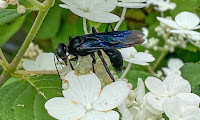While mowing, I hit a nest of… hornets, wasps, bees… I’m not sure which, but they had stingers and they weren’t afraid to use them.
So, with my recent experience, and subsequent emergency department visit and epinephrine injection, I decided to write about insect stings.
I really consider myself a friend of the bees, and have dedicated so much time to make my yard a pollinator habitat—from never using insecticides to following No Mow May and a Leave the Leaves philosophy, I happily coexist with many bees in my yard.
Wasps too, as I’ve been able to get up close an personal with Gold Digger Wasps (Sphex ichneumoneus) and Great Black Wasps (Sphex pensylvanicus). But, while many of these insects are beneficial, some are assholes.All of these stinging insects are in the same animal kingdom order, Hymenoptera, which is then broken down into other families including Apidae and Vespidae, among others. Honey bees and bumblebees are Apidae while yellow jackets, wasps and hornets are Vespidae. The Apidae have barbed stingers that get ripped off the bee, killing it, while most of the Vespidae have non-barbed stingers to they can strike several times.
I won’t get into any further detail because realistically, if you get stung, it doesn’t really matter which one did it, the reactions—and treatments—are all essentially the same. Which is good because, most people are probably like me, and when you start getting stung, you just want to get away.
A single sting may only cause a mild, local reaction. These are immediately painful followed by swelling within a few minutes. The swelling will usually go down in a few hours, and for the most part, reactions like this really only need an ice pack.In some people, a single sting will lead to what’s called a “large local reaction,” which is, you guessed it, a local reaction that’s a bit larger than normal. I see many patients in the emergency department with reactions like this because the swelling continues and this can be quite concerning.
Swelling eventually peaks in about 48hrs. The key with these is that they are still a “local” reaction and do not have any symptoms like nausea, shortness of breath or low blood pressure. Large local reactions get better over several days (5-10) and you can use ice packs, NSAIDs (like ibuprofen), and antihistamines (Claritin or Benadryl). Recovery can be given a bit of a boost by singe dose or short course of prednisone.
Insect stings RARELY get infected, but if swelling, redness, or pain is developing more than 48hrs later, antibiotics MAY be needed.But while these types of reactions can be painful and annoying, for some people stings can be fatal. There are about 70 deaths per year in the US attributed to insect stings, and it really can be from a single sting.
When the reaction causes symptoms beyond the area of the sting, it’s considered “systemic” and can affect different organs.
This chart from UpToDate, a trusted clinical reference, shows some of the various symptoms that can occur from a sting.
In my case the other day, I thought it was going to be like other stings I had had in the past. Painful, but I didn’t think it was going to affect my day very much. I was getting some swelling (hand, arms, leg), but wasn’t too worried about it.
Then I got itchy. Very itchy. Like I wanted to “peel my skin off itchy.” I figured I’d take some antihistamines (I carry 50mg of Benadryl/diphenhydramine and 40mg of Pepcid/famotidine in my first aid kit) and head home. A few minutes after taking the meds, my lower lip started to swell. And then my upper lip. Shit.
Now, let’s back up a few hours. Earlier that morning, I had my annual physical exam and was talking to my PCP about EpiPens. We talked about me just having one, “just in case,” even though I’d never had a bad reaction, but then we started talking about the costs and then we started talking about something else and that was that. THEN, my wife, who did not know about that conversation, specifically told me to watch out for bees before I went out to mow. This was all going through my mind as I was tying to scratch my skin off and my lips were starting to look like balloons.So, I was off to the Emergency Department.
I got my shot of epinephrine, I got an intravenous steroid, and I got watched for a bit to make sure I didn’t have a rebound reaction or any other problems.
Looking back at the list of systemic symptoms, you'll see that the sting can cause cardiac and respiratory problems, and, when the swelling affects the throat or airways, breathing can be problematic. Fortunately, none of that occurred with me, but early treatment is important to prevent progression. And, patients are told that if they ever need to use their own EpiPen, that it's critical to still be seen at an Emergency Department because the effects of the Epi can wear off and the allergic/anaphylactic reaction can come back.
Despite this blatant attack, I still consider myself a bee-friend. The majority of these stinging insects will only attack when trying to defend their home, although yellow jackets can be more aggressive.
For most people, avoiding bees and other stinging insects is common sense, but injuries occur when we inadvertently disturb their hives and nests. And because that happens accidentally, it's best to be prepared for these encounters, like any other accident, and carry antihistamines (talk to your health care provider for specific recommendations), and if you've had a serious reaction, an EpiPen.
Please remember, the information presented here, including but not limited to, text, graphics, images and other material contained on this website are for informational purposes only. No material on this site is intended to be a substitute for professional medical advice, diagnosis or treatment.











Comments
Post a Comment